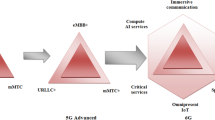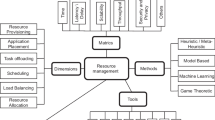Abstract
This paper utilizes the cognitive radio (CR) spectrum to the fullest extent for extended applications requiring discretion. The CR technology provides various supports for cognitive radio networks (CRNs). The latter has CR nodes that sense free channels. Then, the CRN allocates the unused channels to secondary users (SUs) or unlicensed users. This allocation is termed the spectrum handoff. In this paper, by considering the identical channels in CR networks, a novel machine learning algorithm (the support vector machine—SVM) is employed. In addition, the queuing model of the preemptive resume priority M/M/1 is used. The proposed spectrum handoff algorithm selects the best possible CR network channel. The spectrum handoff algorithm uses the stated SVM algorithm scheme, which covers the transmitted and received power, the minimum service time, the data rate and the maximum vacancy time for the SU, to attain the maximum throughput. However, in multi-user greedy channel selection (GCS), only two parameters are considered. The proposed spectrum handoff algorithm based on the SVM scheme enhances the performance, and the SU throughput is improved to 68.7%. This approach is better than the GCS channel selection scheme. Additionally, this approach decreases the number of spectrum handoffs. As a result, the training accuracy of the SVM method is 97.6%, and it outperforms conventional methods.















Similar content being viewed by others
References
I.F. Akyildiz, W.Y. Lee, M.C. Vuran, S. Mohanty, A survey on spectrum management in cognitive radio networks. IEEE Commun. Mag. 46(4), 40–48 (2008)
I.F. Akyildiz, W.Y. Lee, M.C. Vuran, S. Mohanty, Next generation dynamic spectrum access/cognitive radio wireless networks: a survey. Comput. Netw. 50(13), 2127–2159 (2006)
T.A.H. Ayman, A.H. Zahran, T. ElBatt, Improved spectrum mobility using virtual reservation in collaborative cognitive radio networks, in Computers and Communications (ISCC) (2013), pp. 1–6
S. Bhattarai, J.M.J. Park, B. Gao, K. Bian, W. Lehr, An overview of dynamic spectrum sharing: ongoing initiatives, challenges, and a roadmap for future research. IEEE Trans. Cogn. Commun. Netw. 2(2), 110–128 (2016)
C. Cordeiro, K. Challapali, C-MAC: a cognitive MAC protocol for multi-channel wireless networks, in 2nd IEEE International Symposium on New Frontiers in Dynamic Spectrum Access Networks (2007), pp. 147–157
I. Christian, I. Chung, J. Lee, Spectrum mobility in cognitive radio networks. IEEE Commun. Mag. 50(6), 114–121 (2012)
J. Christopher Clement, D.S. Emmanuel, J. Jenkin Winston, Improving sensing and throughput of the cognitive radio network. Circuits Syst. Signal Process. 34(1), 249–267 (2015)
A. Domenico, E. Strinati, M. Benedetto, A survey on MAC strategies for cognitive radio networks’. IEEE Commun. Surv. Tutor. 14(1), 21–44 (2010)
H. Gill, L. Dong, C. Nguyen, T. Gill, B.T. Loo, Declarative platform for high performance network traffic analytics. J. Clust. Comput. 17(4), 1121–1137 (2014)
X. Gong, S.A. Vorobyov, C. Tellambura, Optimal bandwidth and power allocation for sum Ergodic capacity under fading channels in cognitive radio networks. IEEE Trans. Signal Process. 59(4), 1814–1826 (2011)
D. Lee, W. Yeo, Channel availability analysis of spectrum handoff in cognitive radio networks. IEEE Commun. Lett. 19(3), 435–438 (2015)
A. Lertsinsrubtavee, N. Malouch, S. Fdida, Spectrum handoff strategy using cumulative probability in cognitive radio networks, in International Congress on Ultra Modern Telecommunications and Control Systems and Workshops (2011), pp. 1–7
M. Aggarwal, T. Velmurugans, M. Karuppiah, M.M. Hassan, A. Almogren, W.N. Ismail, Probability-based centralized device for spectrum handoff in cognitive radio networks. IEEE Access 7, 26731–26739 (2019)
J. Mo, H. So, J. Walrand, Comparison of multichannel MAC protocols. IEEE Trans. Mob. Comput. 7(1), 50–65 (2008)
M. Morteza, R. Fathi, V.T. Vakili, Proactive spectrum handoff protocol for cognitive radio ad hoc network and analytical evaluation. IET Commun. 9(15), 1877–1884 (2015)
M. Pushp, S. Awadhesh Kumar, A survey on spectrum handoff techniques in cognitive radio networks, in International Conference on Contemporary Computing and Informatics (IC3I) (2004), pp. 996–1001
R. Shalini, S.S. Manivannan, Optimized approach for data sharing in WRN using NS2 simulation. J. Adv. Res. Dyn. Control Syst. 10(5), 1429–1434 (2018)
J. So, N. Vaidya, Multi-channel MAC for ad hoc networks: handling multi-channel hidden terminals using a single transceiver, in Proceedings of ACM MobiHoc (2004), pp. 222–233
Y. Song, J. Xie, Proactive spectrum handoff in cognitive radio ad hoc networks based on common hopping coordination, in INFOCOM IEEE Conference on Computer Communications Workshops (2010), pp. 1–2
Y. Song, J. Xie, Common hopping based proactive spectrum handoff in cognitive radio ad hoc networks, in IEEE Global Telecommunications Conference (2010), pp. 1–5
Y. Song, J. Xie, ProSpect: a proactive spectrum handoff framework for cognitive radio ad hoc networks without common control channel. IEEE Trans. Mob. Comput. 11(7), 1127–1139 (2012)
M. Timmers, S. Pollin, A. Dejonghe, A distributed multichannel MAC protocol for multi hop cognitive radio networks. IEEE Trans. Veh. Technol. 59(1), 446–459 (2010)
C.W. Wang, L.C. Wang, F. Adachi, Modeling and analysis for reactive-decision spectrum handoff in cognitive radio networks, in IEEE Global Telecommunications Conference (2010), pp. 1–6
L.C. Wang, C.W. Wang, Spectrum handoff for cognitive radio networks: reactive-sensing or proactive-sensing?, in IEEE International Performance, Computing and Communications Conference (2008), pp. 343–348
C.-W. Wang, L.-C. Wang, F. Adachi, Modeling and analysis of multi-user spectrum selection schemes in cognitive radio networks, in IEEE 20th International Symposium on Personal, Indoor and Mobile Radio Communications (2009), pp. 828–832
W. Zhang, Handover decision using fuzzy MADM in heterogeneous networks, in IEEE Wireless Communications and Networking Conference (2004), pp. 1–6
N. Zhao, Joint optimization of cooperative spectrum sensing and resource allocation in multi-channel cognitive radio sensor networks. Circuits Syst. Signal Process. 35(7), 2563–2583 (2016)
Author information
Authors and Affiliations
Corresponding author
Additional information
Publisher’s Note
Springer Nature remains neutral with regard to jurisdictional claims in published maps and institutional affiliations.
Rights and permissions
About this article
Cite this article
Sumathi, D., S Manivannan, S. Machine Learning-Based Algorithm for Channel Selection Utilizing Preemptive Resume Priority in Cognitive Radio Networks Validated by NS-2. Circuits Syst Signal Process 39, 1038–1058 (2020). https://doi.org/10.1007/s00034-019-01140-y
Received:
Revised:
Accepted:
Published:
Issue Date:
DOI: https://doi.org/10.1007/s00034-019-01140-y




